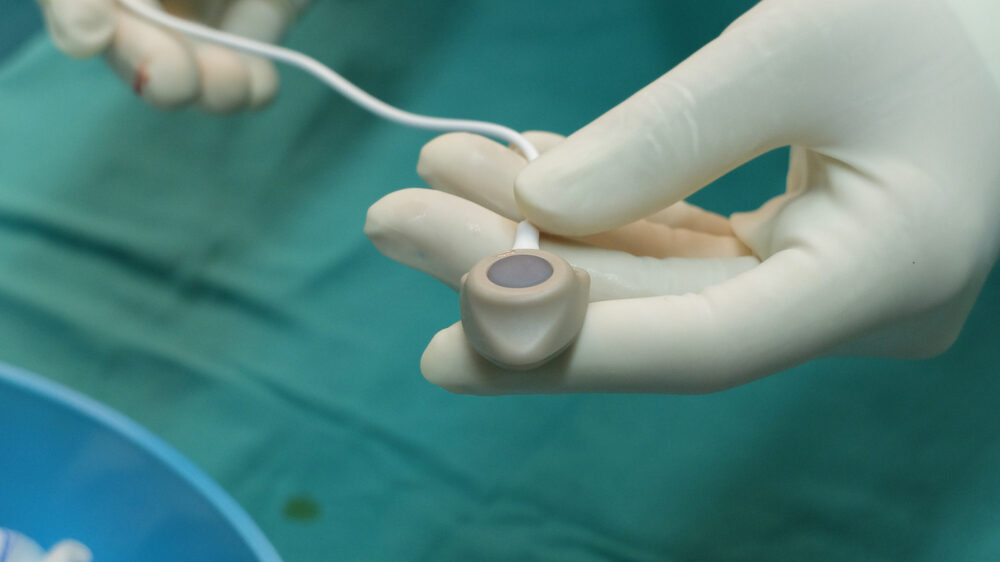Eligible for a Bard PowerPort lawsuit?
Lawsuits Claim Bard Power Port Problems Were Withheld from Public, Doctors for Years

- Bard Power Port is an implantable device placed below the skin to provide catheter access for medications and fluids
- Since the device was introduced, Bard Power Port problems have been reported, including blood clots, infections and other injuries
- Lawsuits allege that Bard was aware of Power Port design defects and concealed information
- Individuals who have suffered injuries are now filing Bard Power Port lawsuits to obtain financial compensation for injuries or the death of a loved one
- LEARN MORE ABOUT BARD POWER PORT LAWSUITS
After the U.S. Food and Drug Administration (FDA) released millions of medical device injury reports last year, which had previously been concealed from public view, a growing number of product liability lawsuits are now being filed against Bard, alleging that the manufacturer hid problems involving fractures and infections with it’s Power Port device from consumers and the medical community.
The Bard Power Port is a vascular access device, which is implanted below the skin to provide a catheter port for easy delivery of medications to a patient’s blood stream, such as chemotherapy. It consists mainly of an injection port, where the needle is inserted to deliver medications; and a polyurethane catheter tube, which carries the drug into the blood vessel.
Although the manufacturer promoted the implantable port catheters as safe and effective, recently released FDA adverse event reports have shown an alarmingly high rate of Bard Power Port problems over the last two decades, which lawsuits now allege is due to a defective design.
In this post, AboutLawsuits.com will outline the allegations raised in these Bard Power Port lawsuits, and describe how the manufacturer was able to conceal information about fracture and migration injuries for so long.
Information on This Page About Bard Power Port Problems
- Lawsuits Allege Bard Power Port Design Defects
- How Bard Hid Power Port Problems For Decades
- Problems Exposed By Reporting Guideline Changes
- Bard Blamed Physicians For Power Port Fractures and Migrations
- Power Port Catheter Infections Risk
- Bard Failed to Correct Known Defects with Power Ports
- See If You Qualify For A Bard Power Port Lawsuit
Lawsuits Allege Bard PowerPort Design Defects
Nearly identical allegations have been raised in lawsuits filed throughout the federal court system over the past few months, each indicating that problems with the Bard Power Port and compatible Groshong catheters caused patients to experience severe and devastating injuries.
Given common questions of fact and law raised in the growing litigation, a motion was filed last month to centralize and consolidate all Bard Power Port lawsuits before one judge for coordinated discovery and pretrial proceedings.
While the consequences experienced by each plaintiff are different, each of the lawsuits allege that problems with the Bard Power Port stem from a defective and unreasonably dangerous design, involving Chronflex components made with an improper mixture of polyurethane and barium sulfate.
The use of barium sulfate in the Chronoflex material has been found to weaken the mechanical integrity of the polyurethane catheters, according to the lawsuits. This has resulted in a weakening of the catheters, leading to micro fractures, degradation, fissuring and cracking, which can cause fragments of the catheter to break away and migrate throughout the bloodstream, or build up bacteria.
Plaintiffs not only maintain that Bard knew or should have known about these design problems, but indicate that the manufacturer intentionally concealed information about the Power Port problems from consumers and the medical community for years.
How Bard Hid Power Port Problems For Decades
The FDA issued clearance for Bard to begin marketing the PowerPort under the special §510(k) provision of the Medical Device Amendments to the Food, Drug, and Cosmetic Act. Unlike the extensive and rigorous FDA pre-market requirements for medical devices, approval under §510(k) allows the marketing of medical devices if the manufacturer can show that it is substantially equivalent to other previously approved devices.
Manufacturers granted these special approvals under the §510(k) provision may also be excluded from normal adverse event reporting requirements. In the case of the Power Port, Bard was granted these reporting exemptions, which only required the manufacturer to submit certain types of reports through the FDA’s Alternative Summary Reporting (ASR) program. This allowed reports of Bard Power Port problems to be sealed from the healthcare industry and the general public.
As Bard continued to file quarterly PowerPort failures through the ASR dating back to the early 2000’s, the public and the healthcare industry were not provided adequate warnings or information about the common failures being experienced by patients, according to the lawsuits. This prevented patients and the medical community from making an informed decision when deciding whether to have the port catheter implanted.
Problems Exposed by Reporting Guideline Changes
In May 2019, an investigative report by Kaiser Health News was published that highlighted how manufacturers were concealing problems and patient injuries from the public through the ASR program, instead of submitting reports involving problems to the agency’s Manufacturer and User Facility Device Experience (MAUDE) database, which is publicly accessible.
In response to the public outcry, the FDA quickly responded by announcing that it would release more than 6 million adverse event reports that had not previously been seen by the public. This included information about problems with Bard Power Port and a wide array of other medical devices.
It was not until February 2022 that the FDA finally disclosed information about the adverse events, and it was subsequently discovered that the data included reports involving complications with the Bard Power Port, including pinch-off events and device failures, which the manufacturer had self-categorized as “known risks” or placement errors by physicians.

Bard Port Catheter Lawsuit
Serious and life-threatening injuries have been linked to problems with Bard PowerPort. Lawsuits are now being pursued by individuals who suffered injuries from the implantable port catheter fracturing or migrating.
Learn More About this Lawsuit See If You Qualify For CompensationBard Blamed Doctors For Power Port Fractures & Migrations
Since Bard was only required to submit certain types of adverse events under its unique classification, lawsuits claim the manufacturer attempted to conceal the defective design of the Power Port by classifying the problems experienced as “known-risks”, or even more specifically, “compression or pinch-off events”, which Bard attempted to blame on the implanting physicians.
Lawsuits now allege that Bard knew the Power Port and Groshong catheter design problems were contributing to these pinch-off and fracturing events, causing fragments of the catheter tubing to break away and migrate throughout the patients bodies.
Rather than addressing the dangerous design defect, lawsuits claim that Bard attempted to shift the blame for the problems onto implanting physicians, issuing warnings that indicated if a physician implants the device incorrectly it could cause a “compression or pinch-off” event.
Lawsuits now maintain that as a result of Bard’s failure to address the Power Port and Groshong catheter problems, individuals have suffered long-term consequences, resulting in blood clots, cardiac arrhythmia, cardiac punctures, pulmonary embolisms, tearing of blood vessels, and organ damage. Several Bard Power Port wrongful death lawsuits have also been filed, claiming the injuries caused by the device resulted in fatal injuries.
Bard Power Port Catheter Infection Risks
Lawsuits also allege that these design problems have resulted in severe infections from the Bard Power Port, indicating that the deterioration of the barium sulfate pockets in the catheters creates a roughened catheter surface, which leads to the collection and build-up of microbes,
Individuals are filing Bard PowerPort infection lawsuits claiming the defective designs caused them to develop dangerous bloodstream infections or sepsis, while also requiring replacement surgery and to replace the implantable port.
EXPERIENCE BARD CHEMO PORT PROBLEMS?
Share your story with the AboutLawsuits.com community.
Bard Failed To Correct Known Defects with Power Ports
While Bard has made several statements suggesting that complications experienced by patients with Power Ports were the result of the implanting doctor, lawsuits indicate that the manufacturer actually knew, or should have known, that barium sulfate was causing the deterioration of the polyurethane catheters, yet failed to take steps to address the problems.
Individuals are claiming Bard failed to adequately search for safer design alternatives, maintaining that fracture and infection risks could have been significantly reduced or avoided with design modifications that encapsulate the radiopaque compound, or by using a different polymer formulation.
However, rather than altering the design to make the implantable port catheters safer for users or issuing a Bard Power Port recall, the manufacturer chose to continue aggressively marketing the their product as safe, exposing additional patients to the potential risks.
Have a Bard PowerPort Lawyer Review Your Case
As the litigation moves forward, lawyers are continuing to provide free consultations and claim evaluations to help individuals nationwide determine if they may be eligible for Bard PowerPort lawsuit settlement. New cases continue to be filed for problems caused by the catheter port, including:
- Infections
- Blood Clots
- Perforations
- Catheter Fractures
- Wrongful Death
Submit information about your potential claim for review by a lawyer. There are no fees or expenses unless a settlement or recovery is obtained.
Find Out If You Qualify for Port Catheter Compensation
1 Comments






lindyDecember 23, 2023 at 1:21 am
The sad thing about all this is...defendants say there port is good its the other parts that fail..the point is when they manufacture it they should know and be responsible for there product.When it comes to liability they are playing a name game...while the people that are suffering or who have died already will never see responsability for there suffering....the court should be done with this ca[Show More]The sad thing about all this is...defendants say there port is good its the other parts that fail..the point is when they manufacture it they should know and be responsible for there product.When it comes to liability they are playing a name game...while the people that are suffering or who have died already will never see responsability for there suffering....the court should be done with this case and remove them from manufacturing and from saying there product is safe from the FDA...period!